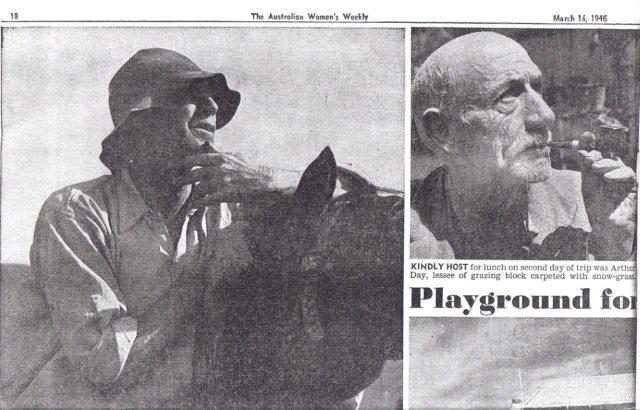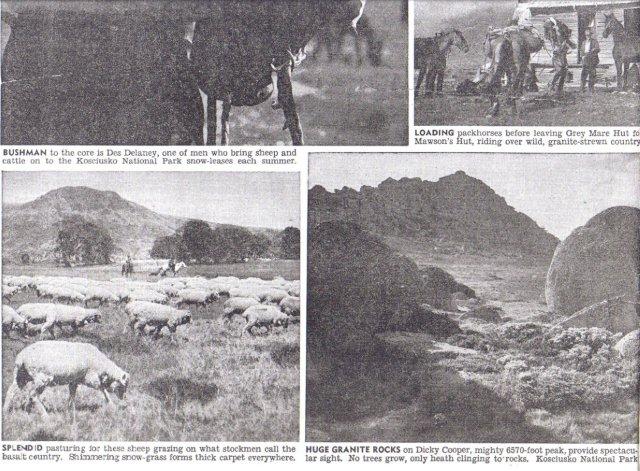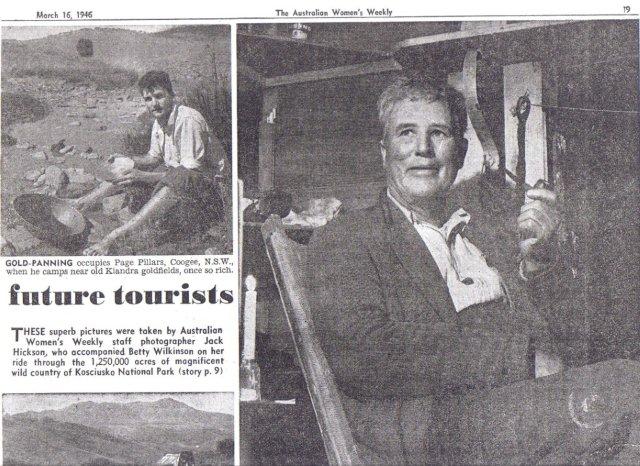
Home | Pioneers | Contact Us | Copyright/Disclaimer
Tourists on the Monaro
KOSCIUSKO | YARRANGOBILLY CAVES
The Manaro plains, stretching away from the foothills of the Australian Alps, enclosed by the Manaro Range and constituting the most elevated tract of land in the State, claim the attention of scientist as well as of the tourist, comprising as they do lands that, to the understanding, tell the story of days that, countless aeons since, were lost in the lap of time. At Cooma and in its immediate neighbourhood earthquake shocks which follow a north west and south east wave, are not infrequent. Even to-day, these, it is stated, suggest the existence of crustal crackings and orogenic movement. Sixty-seven miles away from Cooma, Kosciusko, with its snow-clad summit of 7328 feet high, scarred and worn by the passing of unnumbered centuries, has disclosed to eminent geologists distinct evidence of phenomena dating back to the Pleistocene glaciation period, estimated variously as from a quarter to half a million years ago at least.
It is seemingly scientifically certain that Kosciusko was once a glittering icefield, the present day traces of which throw out a bold challenge in importance to the most famous of the world's glacial regions.
Living in a land the major portion of which rejoices in sunshine even in winter, the average Australian has little conception of the extent of the Alpine snowfields, where, in many places, drifts are found up to 20 feet in depth, whilst even on the level there may be several feet of snow.
As a tourist country Manaro has not the dainty charm that appeals so in the coastal areas. It has been created on grander and more rugged lines. In the very middle of some of its far stretching plains, there are often visible huge masses of tumbled rocks that tell eloquently of some great nature disturbance; the trees that clothe the hillsides are stunted and bent, as though their lives had been passed in a stern struggle with winds that blow with a strength and continuity not known in milder climes; the vegetation has not the bright emerald green tint that glitters in the kindly sunshine of temperate areas. Yet Manaro has an attraction peculiar to itself. Its sombre and weather scarred headlands grip the imagination, and its rough and broken country has a fascination of its own.
Forming as it does, the water shed between streams flowing east to the coast, south to the Snowy River, and west and north to the Murrumbidgee, its face is crossed and bisected by many miles of rivers, whose waters, rising on some snow clad hillside, trickle at their source with baby prattle over the mountain's stony bosom to dash, miles farther on, with thunderous tone over tremendous
rock terraces as a dense cloud of tumbling waters, and then as a broad band of gleaming silver roll in a musical whisper through wide pasture lands. For hundreds of miles along these singing waters the trout hides, and ever and anon is seen flushing as a silver arc leaping from the depths.
In winter these same rivers often run as a dark line between gleaming snow banks along which trees and hillsides are draped in a heavy mantle of purest white.
 |
 |
 |
 |
 |
 |
| These images were supplied by Judy Parrish [rjparish-at-@bigpond.com] |
It was not till 1909, when the Government completed the erection of a modern, and in conjunction with the Creel, an almost entirely self contained hotel at an elevation of 5000 feet above sea level and only 17 miles from the summit of Kosciusko, that the possibilities of the Manaro as a tourist resort were recognised.
Within 18 hours of Sydney, a place had been found that has now become the Mecca, not only of Australians, but of tourists from the far corners of the world. There where "the air is clear as crystal" the key has been given that unlocks a veritable fairyland. Development work has made possible, without exertion, the journey not only to the hotel, but to the summit of the mountain some 2,300 feet higher. It has offered extensive views of the ranges and spurs of the Great Divide, the far stretching plains of Manaro, and the wide valley of the Murray. It has opened up the wonderful Alpine Lakes, Lake Mereweather or the Blue Lake 6150 feet above sea level, with an area of 40 acres and a depth of 70-75 feet, Hedley Tarn 6070 feet above sea, Lake May, also called Lake Cootapatamba or the place where the eagles drink, a quarter of a mile in length, with a depth of 17 feet and an elevation of 6340 feet, and Club Lake or Harnett's Lake or Garrard's Tarn.
Situated as it is, it is small wonder that the Hotel Kosciusko, which in the first instance provided accommodation for 70 only, proved too small. It was recognised that on the mountain in summer and winter alike, brain fag and bodily weariness would find that rest and change which meant restoration of mental and physical vigour, there the scientist could find new fields wherein to work, whilst the nature lover and the artist had unfolded continuously before him scenes of surpassing beauty. So it was that the accommodation has been gradually increased till the hotel can now provide for 150 guests, and consideration is being given to a still greater enlargement of the building, and life at the hotel is not "the same thing over and over again." The management has so catered for the amusement and enjoyment of its guests that there is no dull moment there.
Snow sports are the most popular form of
amusement and in this connection, several clubs have been formed. The most prominent are:
The Alpine Club of Australia; the Ski Club of Australia; the N.S.W. Public Service Ski Club; the School Ski Club of Australia.
These are clubs primarily devoted to winter sport which includes ice skating on specially prepared surfaces. Summer sport is provided for by fishing, golf, tennis, croquet and riding. As snow has been written of, it might be noted that the winter temperature often falls as low as 15* F sometimes it recedes to 9* F., but this is not colder than at Cooma where 2.5* F has been recorded and where registrations of 15* F are by no means uncommon.
Kosciusko, so far as is known, was first ascended by Count Strezlecki and Messrs. McArthur and Riley on February ]5th, 1840, when it gained its name from a fancied resemblance to the tomb at Cracow of the famous Polish Patriot, Statesman and Warrior. Some eleven years later, the Rev W. B. Clarke geologically examined it, and named the range of which it forms part, Muniong. He then pointed out the existence of past glacial action to which reference has earlier been made in this article. In 1855 an exploration of Mt. Kosciusko was made by Baron F. von Muller, and it was not till thirty years later that Dr. R. von Lendenfeld made an examination of the area and reported to the Minister for Mines. Thereafter, examinations were made at fairly frequent intervals by, amongst others, Messrs. R. Helms, J. B. Jaquet, A.R.S.M., F.G.S., Rev. J. Milne Curran, A. E. Kitson, F.G.S., and Mr. Thorn, and Professor Sir T, Edgeworth David.
Although Mt. Kosciusko has been spoken of as the highest peak in Australia, its companion mountains, Mt. Townsend 7260 and Mts. Clarke and Etheridge of 7000 feet each should not be forgotten.
When nature gives she does so in no niggard fashion, but distributes her gifts in full measure and with a lavish hand. So in compensation for the sombre colouring and rugged shape in which she has created Manaro, she has made it a spot where,
"In its highlands and its lowly places,
The young old men have rosy faces."
and splendid vigorous health is the common enjoyment. She has bestowed upon it its many miles of ever running, swift flowing, snow fed trout rivers; she has guarded it from all knowledge of the devastating droughts which she inflicts upon other parts; she has girdled it with the far stretching splendour of the snowfields of the Australian Alps crowned by Kosciusko's ice bound summit, and she has hidden within it the wonderful limestone formations of the Yarrangobilly Caves. These latter are about 66 miles from Cooma, being 14 or 15 miles north of Kiandra. They are approached by a good road which was
constructed in 1891 by G. Goodman under a Government contract, the usual method of travel being by motor car, The descent down the hills which en close the caves reveals scenes of wondrous beauty. Hillsides, clad with stately trees challenging the distant mountains, bulk grandly skywards, and from the black purple depths of vast gorges come the faint chorus of singing waters. Piled together like the huge battlements of some great city, formations of mineral stained rocks guard the entrance to the valley wherein, not far from where the Yarrangobilly River unwinds as a glistening thread. the glories of
the caves may be found.
Though these caves are not as well-known. and consequently not as popular as those at Jenolan they are not one whit less beautiful in formation: whilst in many places the colouring is even more intense. The Caves were accidentally discovered! in 1834 by Mr. J. Bowman who resided half way between Talbingo and Bowler's Flat. Mr. Bowman, whilst seeking cattle was overtaken by a thunderstorm and took cover in what, in after years, was. called the Glory Caves. Five years later, in 1839, Sir Terence Aubrey Murray and Surveyor Mote, whilst on an exploring expedition discovered the formations, and after an examination of the Glory Caves lasting for a whole day, they took away a pack horse load of specimens which are now in the Melbourne Exhibition. Other caves were from time to time discovered and so opened up as to be made available for inspection by the public. In 1866, Alexander Brownlie, who acted as guide.. conducted Earl Belmore, the Governor of the Colony, through the caves, this being the first occasion on which they had been inspected by Vice Royalty.
The Glory Caves - there being two immediately adjoining - have been called North and South, others are the Castle, Jersey, Harrie Wood, Creek and Jillabinan. The Jersey Cave was discovered some two months before the visit to Yarrangobilly of the Earl of Jersey in January 1892, and the Castle about 1893; the Jillabinan was not discovered till 1910
It is not possible to give here anything but the faintest description of the wondrous and infinite glory of design and colouring which have been opened up in this limestone area. The caverns, from whose walls countless of dainty mysteries or miracles extend horizontally in shapes of ever varying beauty, from whose crystal floors numberless stalagmites stretch forth as though to clasp stalactites equally numerous coming to meet them from the roof, have their walls and formations patterned and pierced, traced and etched, with metal stains which, in combination on their crystal bases, create a colour scheme varying from purest white, through silver to amber, yellow, rose and pink, even to black. Such formations as King Solomon's Temple, Lady Jersey's Shawl, Jack Forrest's Hall, the Flower Garden, Minerva's Temple, and the Bath of Venus, as the lights play on them, with colour rushing to meet colour, forming stalagmite and stalactite, alcove and grotto, pillar and terrace, into exquisitely fashioned forms of translucent light, give birth to the conviction that in the Yarrangobilly Caves nature has fashioned a Museum for all that in her is beautiful in form and colour.
Near by is a thermal spring, whose waters pleasantly warm, are led into a bath largely availed of by visitors.
The Caves, as also Hotel Kosciusko and the Creel, are under the control of the Government Tourist Bureau. A well conducted Accommodation House, competent guides, a run through the wide pasture lands of Manaro, the snow clad hills of the Australian Alps, the ascent of Kosciusko, the trip round the mountain lakes and the wonders, of the caves, foretell in no uncertain manner that in the not distant future the Manaro District will, beyond all others, be the tourist resort of Australia.
Transcribed by Pattrick Mould, April 2003, from the book "Back to Cooma" Celebrations, Felix Mitchell, 1926, p89-90
|